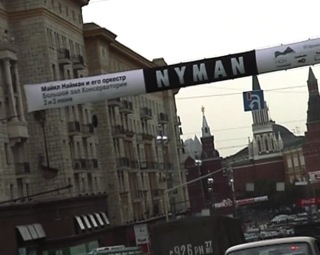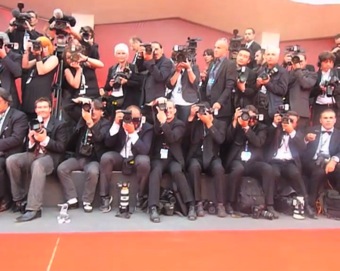Michael Nyman’s Palimpsest of Man With A Movie Camera
In a new work called NYman With A Movie Camera, Michael Nyman has conducted a really interesting experiment by taking the music he wrote a few years ago for Vertov’s Man With A Movie Camera, and employing it again, this time for his own remake of Vertov’s original using his own visual archive as source material. Nyman’s archive largely consists of footage he has filmed himself since the early 90s in different parts of the world he has visited to give concerts. This produces the first difference between Vertov’s film and his own version. Where Vertov’s film is a utopian pre-Stalinist vision of the Communist city, Nyman’s becomes a dystopian vision of global post-communist capitalism.
Nyman’s video film is a shot-by-shot remake, that is, it faithfully follows the rhythm of Vertov’s original while preserving as far as possible the subject matter of each shot he has replaced with his own, leaving in a few of Vertov’s original images at strategic moments. In the technical vocabulary of linguistics, what Nyman does is to leave the syntagmatic (horizontal) relations between the shots in tact, while performing paradigmatic (vertical) substitutions. The procedure exemplifies, as Nyman himself observes in his notes on the film, the idea of what Lev Manovich has called the ‘database imagination in modern media art’—the database in question here being Nyman’s own archive. The result is a palimpsest which acts on the original in striking ways (although of course depending on how well the viewer knows the original).

Ironic allusions abound. A tilted shot of an ornate scyscraper reminds you of Moscow but isn’t—it’s Madrid. In lieu of Vertov’s industrial imagery Nyman inserts, among other things, shots of a gramophone record pressing plant. By replacing Vertov’s shots of the camera in the act of filming with his own shots of cameras in action, he reproduces Vertov’s self-reflexivity, but the effect also becomes an historical as well as a grammatical shifter. Where Vertov’s cameraman is sometimes carried in a cradle hanging from a crane, Nyman offers us a television cameraman operating a jib at a public event in Mexico City. It’s an image he perhaps over-uses, but it’s complemented by numerous other shots of cameras, both video and stills, operated by both amateurs and professional photographers—all digital. Vertov’s optimism about the camera-eye is replaced by the enervating ubiquity of postmodern image-making.

This is still a work in progress and in the version shown at the Barbican in October there are a few miscalculations—images which are repeated too often, for instance, and therefore cease to speak; or stills which lacking movement within the frame, seem to linger on the screen, which is never true of Vertov. Nevertheless, knowing Vertov and watching Nyman produces a pleasing mix of anticipation and recognition. How will the sequence in the cutting room fare? Rather nicely—the film strip is naturally replaced by the time-line on the computer screen, but we also get a large pair of scissors being sharpened by an old workman. This is amusing, but when the rows of seats in Vertov’s theatre, animated by trick photography, are substituted in Nyman by the broken seats of an abandoned cinema, he introduces a certain melancholy which is absent in Vertov—a brand of postmodern melancholy which registers an affective dissonance that banishes the utopian optimism of the earlier period. Where Vertov stitches together shots taken in different Soviet cities into an ideal unity, Nyman presents us with diverse scenes taken in a dozen countries on different continents without trying to hide their disparity, or the social inequality they inevitably manifest.
What welds the whole thing together is unquestionably the music. One of Nyman’s finest scores, it originally provided a fresh and modern interpretation of a film belonging to another era. Now it becomes an elusive intertext in its own right, which entails a conundrum about the expressive qualities of film music. If the same music is equally effective with different images, then we surely have to abandon the idea that music directly expresses some hidden truth in what we see on the screen, that it gives us access, for example, to the inner feelings of the characters.
It’s more than film music which is at stake here, but some of our fondest notions of what music ‘means’. Instead of saying that music expresses emotion, perhaps we should be saying that it provides a matrix into which we project our need for feeling. The primary qualities of music are kinetic. It moves us, and therefore we feel moved. In fact, according to Claude Lévi-Strauss, music operates according to two grids. One is physiological, that is, natural and psychosomatic, the other is cultural: it consists in the musical scale, which varies from one culture to another (we can add, also from one historical period to another). Enjoyment of music is thus made up of a multiplicity of excitements and moments of respite, expectations disappointed or fulfilled beyond anticipation. And then we need to add in the multiple associations that are accreted by different genres and particular pieces to become what the musicologist David Osmond-Smith described as ‘the socio-historical connotations associated with a certain style or piece’.
Film music is what Derrida called a supplement, an added element which is nonetheless integral to the whole, and which thereby manifests a shifting and ambiguous quality, sometimes seeming to provide for what is missing, sometimes adding something extra. The originality of Nyman’s film music, above all as it evolved in his collaboration with Peter Greenaway, lay in his avoidance of the former—that’s to say, the conventional function of commentary on the characters’ inner feelings, an effect largely deriving from nineteenth century opera. Instead of this survival of Romanticism, he returned to the Baroque practice of parody, characteristic of composers like Handel, which consists in the reworking of already existing music by the another or the same composer. In other words, the visual database approach he adopts in his remake of Vertov is already there in his own compositional practice, as it could also be said to be present in Handel himself. If we ask what is going on when Handel takes a tune from one context and inserts it into another with new words, we get the same puzzle. But it’s redoubled when it comes to film, because of the way the music and the image inflect each other.
But this can go in different directions. Nyman took up a formal compositional technique and gives it a postmodern twist by borrowing from historical sources such as Purcell and Mozart—as well as, increasingly, himself. In the context of a Greenaway film, narrative but hardly in a conventional way, this inevitably introduced the more general sense of parody, that of burlesque or travesty. In the non-narrative context of the database documentary, the music returns to a more abstract and formal aspect, a dynamic envelope embodying in sound the energy which drives the contemporary world. Ironic to think that in Vertov’s Soviet Union, Nyman would doubtless have been accused of formalist tendencies.
